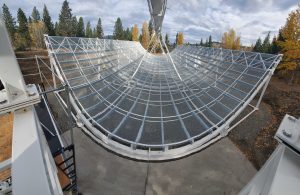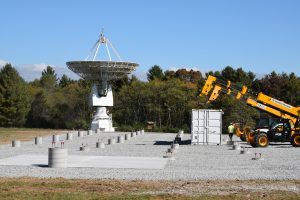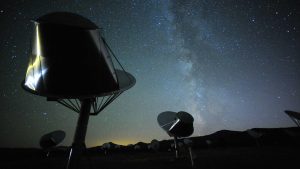CHIME’s new siblings will pinpoint where bursts detected by Canada’s world-renowned telescope come from.
By Meaghan Thurston and Fergus Grieve, with notes from Meaghan MacSween

The new CHIME outrigger telescope being built near Princeton, British Columbia. Credit: Jane Kaczmarek.
In the quest to identify the origins of one of astronomy’s biggest mysteries – fast radio bursts (FRBs) – Canada’s world-renowned telescope, the Canadian Hydrogen Intensity Mapping Experiment (CHIME), is getting backup.
Supported by approximately $10 million in grants from the Gordon and Betty Moore Foundation, the CHIME/FRB Outriggers project has now secured funding to complete the construction of three new radio telescopes to work in conjunction with the main CHIME instrument, located in British Columbia’s Okanagan Valley.
“It has been a pleasure to work with the talented team developing the outriggers for CHIME,” said Robert Kirshner, Ph.D., Chief Program Officer for Science at the Gordon and Betty Moore Foundation. “Despite the burdens of COVID, interruptions in the supply of steel for the antennas, and competition with bitcoin miners for the specialized computer chips that power their computational wizardry, the CHIME team is headed toward a spectacular improvement in the scientific yield of CHIME’s copious FRB discoveries.”
Outriggers to sharpen CHIME’s vision

Foundations for the CHIME outrigger telescope under construction at the Green Bank Observatory in West Virginia. Credit: National Science Foundation/Green Bank Observatory.
With the ability to detect 10-100 times more fast radio bursts than all other telescopes combined, CHIME has had a radical impact on FRB science. The telescope has allowed scientists to observe the vanishingly brief bursts with exquisite time resolution. CHIME’s limitation, however, has been its inability to identify with any precision where the FRBs were coming from. The outriggers will enable this radical leap.
“The CHIME telescope can currently locate the position of a fast radio burst to a patch of sky equivalent to the size of the full Moon. With the addition of the three new outrigger telescopes, this patch of sky can be reduced to the size of a quarter held at roughly 40 km,” explained Patrick Boyle, Senior Project Manager for the CHIME/FRB Outriggers project and Senior Academic Associate in the Department of Physics at McGill University.
By pinpointing FRBs, the new telescopes will allow scientists to zoom in on the environments within galaxies from which the bursts originate and, in so doing, narrow down the possible explanations for their existence.
“Bringing these Outrigger stations online will transform CHIME/FRB’s capabilities, along with our understanding of these millisecond-long blips of radio light,” explains co-investigator Prof. Keith Vanderlinde, Professor at the University of Toronto and the Dunlap Institute. “We’ll know which galaxy — and where in that galaxy — each FRB comes from. That opens up a world of possibilities, from studying their origins to using them to study the wider Universe.”
CHIME’s new siblings

One of the three CHIME outriggers will be built at the Hat Creek Radio Observatory, California, home of the SETI Institute’s Allen Telescope Array (pictured). Credit: SETI Institute.
The outrigger telescopes are smaller versions of the original set to be built in three locations across North America. One of the outrigger sites is in Canada:
- Near Princeton, British Columbia, on land kindly leased to CHIME by HML Mining Ltd. where construction of the new telescope’s reflector has already been completed.
The other two are in the United States and result from partnerships with existing radio astronomy observatories:
- The Green Bank Observatory in West Virginia, where it sits in the middle of the National Radio Quiet Zone (NRQZ).
- The Hat Creek Radio Observatory in California, where the CHIME/FRB project has partnered with the SETI Institute.
“These new outrigger sites will not only increase CHIME’s capabilities to find FRBs’ origins but also unlock a new era in FRB science,” says Dr. Tomás Cassanelli, CHIME/FRB Collaboration member and former Dunlap graduate student. “Soon we’ll be able to probe the matter content of the Universe, where no other experiment has been able to accomplish. The project will also expand the current interferometric capabilities of CHIME and innovate in the direct technique of how to find millisecond duration pulses, which will be a revolution in astronomy.”
Building on a successful collaboration
Representing an amazing convergence of scientists across North America, the CHIME/FRB Outriggers project is a collaboration between several Canadian and international institutes, including McGill University, the University of British Columbia, the University of Toronto, West Virginia University, and the Massachusetts Institute of Technology. Also partnering on the project is the Perimeter Institute for Theoretical Physics, the National Research Council of Canada, the National Radio Astronomy Observatory, and the Green Bank Observatory.
The outrigger project has also received funding by the National Science Foundation (NSF) for the electronics as well as salaries for faculty, postdocs and graduate students located in the United States.
________________________________________________________________________________________
For more information, contact:
Meaghan MacSween
Communications Officer, Dunlap Institute for Astronomy & Astrophysics
University of Toronto
meaghan.macsween@utoronto.ca
The Dunlap Institute for Astronomy and Astrophysics at the University of Toronto is an endowed research institute with over 80 faculty, postdocs, students, and staff, dedicated to innovative technology, groundbreaking research, world-class training, and public engagement.
The research themes of its faculty and Dunlap Fellows span the Universe and include: optical, infrared and radio instrumentation, Dark Energy, large-scale structure, the Cosmic Microwave Background, the interstellar medium, galaxy evolution, cosmic magnetism and time-domain science.
The Dunlap Institute, the David A. Dunlap of Astronomy and Astrophysics, and other researchers across the University of Toronto’s three campuses together comprise the leading concentration of astronomers in Canada, at the leading research university in the country.
The Dunlap Institute is committed to making its science, training, and public outreach activities productive and enjoyable for everyone of all backgrounds and identities.
